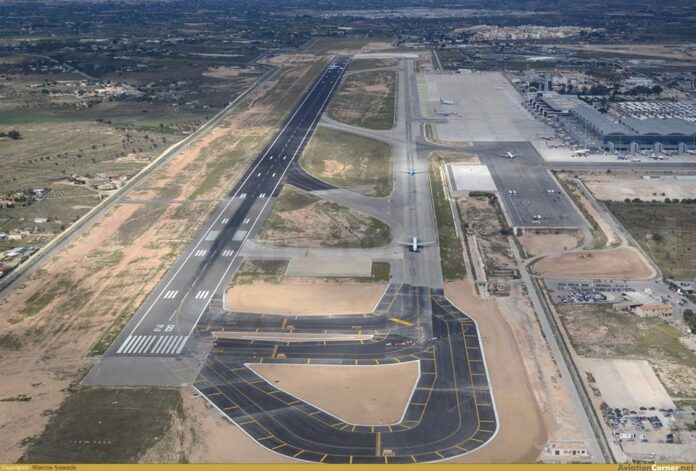The first of the major investments planned by the government, through Aena, to improve the services of the Alicante-Elche Miguel Hernández airport is beginning to take shape.
This is the construction of the new aircraft taxiway, which was agreed to be completed in May, and which is intended to improve the manoeuvrability of aircraft, both during takeoffs and landings, shortening times. Its implementation will enable the airport to gain capacity to accommodate more time slots beyond the 40 operations per hour for which it is currently able to carry out.
The process to contract the construction of this new taxiway was started last June, and it is now that the first phases of evaluation of the bids presented by the construction companies interested in taking on its construction are beginning to arrive.
The call for tenders led to the registration of 19 proposals. However, the first selection has reduced the number of candidates to less than half: eight companies with offers considered valid. The list is made up of Pavasal, Abaldo, Conelsan, FTC Obras y Energía, Matías Arrom Bibiloni, Obrascón Huarte Laín, Padecasa and, finally, Adiante Infraestructuras.
The tender started with an initial budget of more than 17.4 million, with the eight competing submitting prices that range between 14 and the maximum amount of 17.4 million. However, all of them are committed to ensuring the execution period provided for in the conditions of the contract, which is 27 months from the start of the works.
The award should be made before the end of 2024, which would leave the way clear for the works to begin at the end of this year or in the first months of 2025. With this schedule, the new taxiway should be in operation between the last third of 2027 and the beginning of 2028.
The execution of these works, leaving aside their connection with the railway, should coincide with the completion of the extension works of the current El Altet terminal, an action conceived with the purpose of allowing the aerodrome to expand its passenger processing capacity to serve a volume of up to 26 million passengers per year.
The execution of this work would require an outlay of close to 600 million. The drafting of the project will be put out to tender before the end of 2024.

Despite demands from politicians and the business sector, for the moment, neither Aena nor the airlines considered the construction of a second runway necessary for the airport to meet its future growth needs, although this has not been completely ruled out for the future.
The Minister of Transport, Óscar Puente argues that the fact that this second runway is not being built will not limit El Altet’s possibilities, since there are aerodromes that carry 33 million passengers and have a single runway.
At the moment, the data for Miguel Hernández is far from that figure. Its annual record, reached in 2023, is 15.7 million passengers. However, everything seems to indicate that it will be surpassed at the end of this year, since in the first eight months of the year it has already accumulated 12,293,124 passengers, 17.2% more than in the same period in 2023. All this after having experienced the best summer in the historical series with nearly two million passengers in both July and August.
The truth is that the figures for the latter confirm the airport as one of the most promising among the five that occupy the top positions in number of passengers: Madrid Barajas, Barcelona El Prat, Palma de Mallorca and Málaga Costa del Sol. What’s more, Alicante was the one that had the greatest growth in August compared to the same month in 2023: 15.3% compared to the increases of 9.2; 8.9; 5 and 9.6 that the rest recorded (in that order). In fact, El Altet was the only airport that managed to grow at a double-digit rate.





